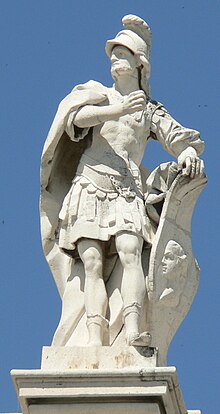Theodoric I
After the death of Emperor Honorius and the usurpation of Joannes in 423, internal power struggles broke out in the Roman Empire.
Theodoric used this situation and tried to capture the important road junction Arelate, but the magister militum Aëtius, who was assisted by the Huns, was able to save the city.
[7] Because the Romans had to fight against the Franks, who plundered Cologne and Trier in 435, and because of other events, Theodoric saw the chance to conquer Narbo Martius in 436 to obtain access to the Mediterranean Sea and the roads to the Pyrenees.
But Litorius, with the aid of the Huns, prevented the capture of the city and drove the Visigoths back to their capital Tolosa.
[8] Theodoric's offer of peace was refused, but the king won the decisive battle at Tolosa, and Litorius soon died in Gothic imprisonment from his injuries.
He therefore accused Theodoric's daughter of planning to kill him, and in 444 had her mutilated - her ears and nose cut off[11] - and sent back to her father,[12] which earned the enmity of the Visigoths.
Theodoric was also an enemy of the Suevic king Rechila in Iberia, because Visigoth troops assisted the imperial commander Vitus in his campaign against the Suevi in 446.
[14] But the ability of this people to conduct a strong defence and the better relations between Geiseric and the Roman Empire led Theodoric to change his foreign policy.
[15] On his return – according to the author Isidore of Seville - Rechiar, with the assistance of Visigoth troops,[16] devastated the area surrounding the city of Caesaraugusta and managed by guile to take Ilerda.
